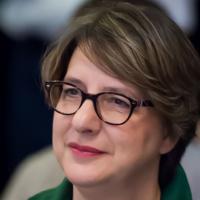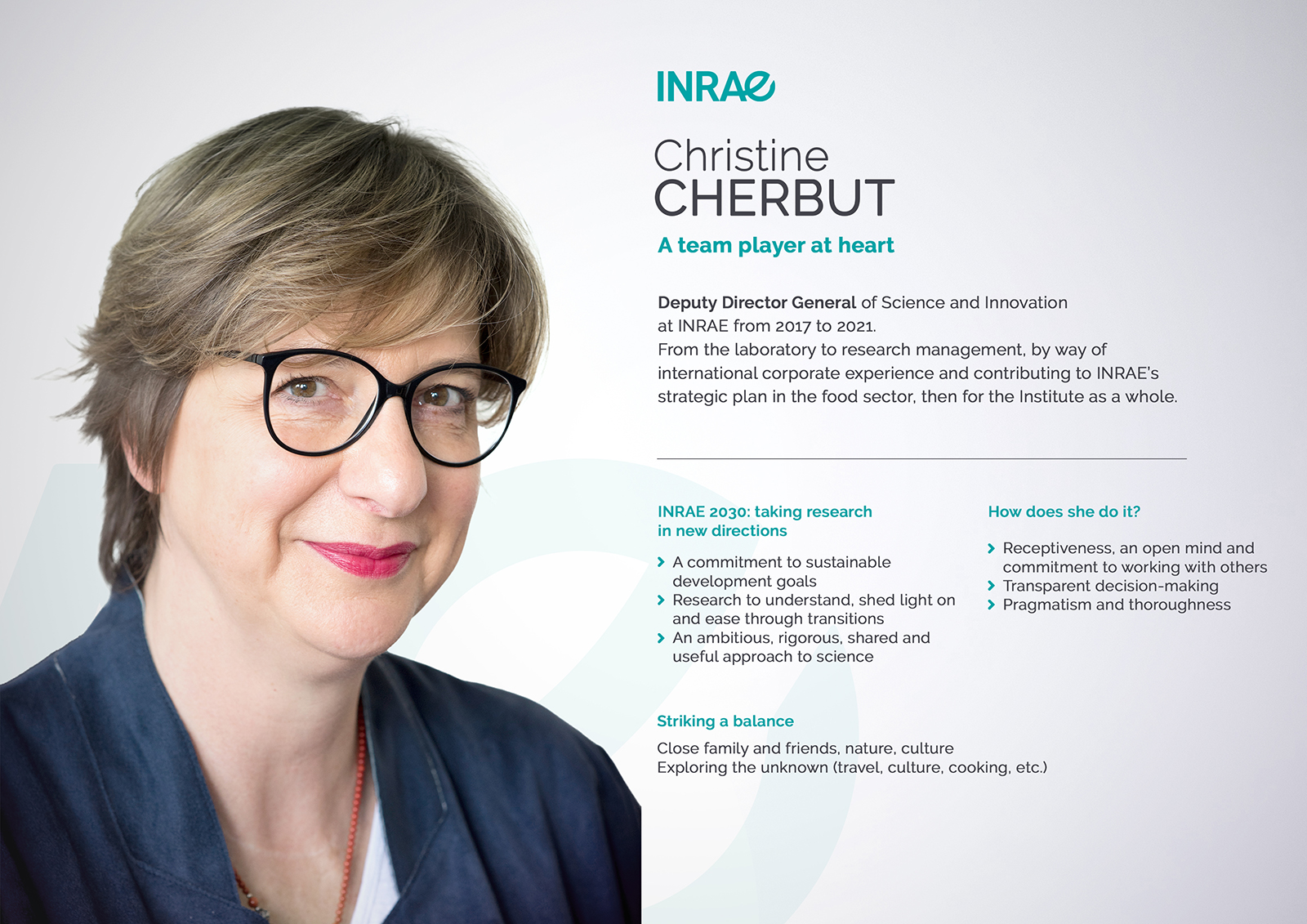
Food, Global Health 5 min
Christine Cherbut, INRAE at heart
As Deputy Director General of Science and Innovation, Christine Cherbut was the last voice in the room when it came to INRAE’s scientific strategic plan from 2017 to 2021. She helped build the new Institute when INRA and IRSTEA merged in 2019-2020. From a working-class background, this pioneer in human nutrition takes a look back at her career at INRAE, a place she likes to call home.
Published on 27 July 2017 (date.last_update 30 March 2020)

Christine Cherbut is proof that it’s possible to be both modest and proud. She weighs her words thoughtfully: “I was born in a working-class neighbourhood in Saint Étienne. Higher studies weren’t really in the cards”. But this little girl never really had much heed for classist notions.
The challenges of cutting-edge and innovative research
“I’ve always loved exploring and learning new things,” says Christine. “I knew from a very early age that being a researcher would suit me.” Fascinated by natural sciences, Christine was initially drawn to medicine. After graduating from secondary school with a science-stream diploma, she enrolled in a biochemical engineering degree in the National Institute of Applied Sciences (INSA) in Lyon. She has fond memories of her time there. “INSA had people from all walks of life, studying in all kinds of fields,” she says. Christine also discovered her passion for rugby at INSA, and remains committed to its sense of camaraderie. “Everyone has a place there, be they big or small, well built or wiry,” she says.
Conquering the microbiota
After graduating from INSA in 1982, Christine was recruited by INRA as a research assistant, a position that served to further her Ph.D. research on the physiochemical properties of dietary fibres at the National Veterinary School of Toulouse. She arrived at INRA Nantes in 1985 and became a research scientist in human nutrition. “Up to that point, we were only looking at animal nutrition,” she says. Christine’s work led her to study diet, which has been a research focus ever since. A real epicurean at heart, she says diet “is a good way to understand the human spirit”. In the 1980s however, the relationship between diet and health was not widely recognised. “You’re just dieticians,” people would say, “you study the effects of soup”.
In the 1980s, the relationship between diet and health was not widely recognised
Ever tenacious, Christine set her sights on studying the human digestive tract. “Microbiota was completely disregarded at the time. The term hardly even existed,” she says. This groundbreaking work helped to establish the Research Centre in Human Nutrition of Nantes (CRNH) in 1995, with Christine as its chief science officer. In 1998, she was nominated director of her research unit. In 2000, she became Vice-President of the Committee on Human Nutrition of the French Food Safety Agency (AFSSA), which later became the French Agency for Food, Environmental and Occupational Health and Safety (ANSES) in 2010.
In the early 2000s, a head-hunter working for Nestlé contacted Christine. “I wasn’t really that keen to leave,” she says. It took three visits to Nestlé’s research centre in Lausanne to sway her. There, as Director of the Scientific Nutritional Support Department, she established the company’s Nutrition, Health and Wellness Programme. Christine was content at Nestlé, but never forgot her INRA roots, and even sat on the Institute’s Scientific Advisory Board during that time.
Scientific strategy, first for Food, then for the Institute as a whole
In 2011, a phone call from then INRA President Marion Guillou (1) triggered Christine’s return to the fold. Marion Guillou asked her to take up the role of Scientific Director for Food, after the passing of the previous Director a few weeks prior. For six years, Christine worked in partnership with the Management Board to bring together research on agricultural production, food processing and diet. “We understood that we could not just look at feeding people; we also had to think about their physical, psychological and social needs too. The health and wellbeing of people ultimately stem from what’s going on in the field.”
INRAE is an extraordinary Institute because it fosters constructive and composed dialogue
Her commitment continued in April 2017 when Christine was named Deputy Director General for Scientific Affairs, then Director General of Science and Innovation in 2020, when INRA became INRAE after merging with IRSTEA. The title changed, but the job stayed the same. For four years, Christine worked at all levels of the Institute, reaffirming her built-in penchant for science, partnerships and organisation: 2017-2021 contract of objectives, INRAE 2030 strategic plan and scientific organisation of the new Institute, scientific foresight studies and metaprogrammes, work on research infrastructures, innovation and open science, updating researcher and engineer evaluations, and strengthening partnerships with other places of higher learning and research. All that in close collaboration with members of the Management Board, scientific division and research support directors, and centre heads. Because, according to Christine, “That is what is extraordinary about INRAE: the way things work and the quality of people foster constructive and composed dialogue”.
Faith in science and the desire to pay it forward
At the end of her term, Christine has several projects in mind. In the immediate future, she will coordinate INRAE’s self-evaluation for September 2021. More broadly, she aspires to a less-consuming professional life, and wants to focus on more forward-looking scientific pursuits, starting with her original field of research: human nutrition. She thinks it’s important to take stock of research at national, European and international levels, and to redefine what’s at stake and what needs more attention in terms of sustainable development goals and ongoing transitions. “It’s exciting to work on topics of global importance. Science is the rock that everything we do is built upon, ambitious and rigorous science. Thanks to that solid foundation, innovation, expert knowledge and support for public policy-making can happen”.
Research and researchers have nurtured me all these years, and I would love to help my young colleagues
Another project particularly close to Christine’s heart is passing on to others what she has received. “Research and researchers have nurtured me all these years, and I would love to be able to give back a little of what I have received. I don’t know exactly how yet, but I would like to help my younger colleagues who are just starting out or taking on new leadership positions by passing on what I have learned over my career in public and private research in terms of human qualities and important behavioural skills, partnerships and coordinating team work, in a context where new, more open and more inter-disciplinary research practices are being used. INRAE is my family”, she says, not without emotion. “Everything that happened to me was unplanned. It was the fruit of a lot of luck, chance meetings, hard work and curiosity. I am happy with where my life is right now”.
(1) Marion Guillou served as President and Director-General of INRA from 2004 to 2012.
- 61 years old, single, child-free
- 1982: engineering degree in biochemistry from INSA Lyon
- 1985: Ph.D. in animal physiology from the National Veterinary School of Toulouse, with dissertation on dietary fibre and digestive motility
- 1986: research scientist in human nutrition at INRA Nantes
- 1995: accreditation to supervise research from INRA Nantes
- 1995–2003: Chief Science Officer of the Research Centre in Human Nutrition (CRHN) of Nantes.
- 1998–2003: Director of the Digestive Functions and Human Nutrition (FDNH) Unit, INRA Nantes.
- 2000–2003: Vice-President of the Committee on Human Nutrition at the French Food Safety Agency (AFSSA)
- 2003–2011: Director of the Scientific Nutritional Support Department at Nestlé
- 2011–2017: Scientific Director for Food, and later for Food, Nutrition and Bioeconomy at INRA.
- 2017-2021: Deputy Director General of Scientific Affairs at INRA, then Deputy Director General of Science and Innovation at INRAE
- From 2021: project manager for the Chair and CEO of INRAE
